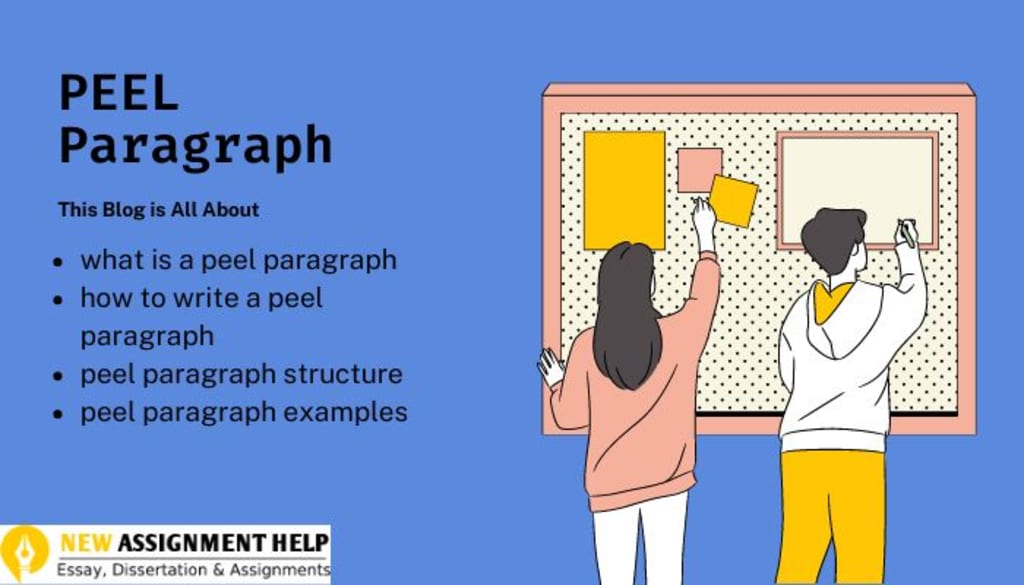How to Write a PEEL Paragraph Structure with Examples
PEEL Paragraph Structure with Examples

Guide to Writing PEEL Paragraphs with Examples
In today's fast-paced world of information, the ability to communicate clearly and concisely is more crucial than ever. Whether you're crafting an academic essay, presenting a business proposal, or engaging in a persuasive argument, your success often hinges on how effectively you can convey your ideas. This is where the PEEL paragraph structure comes into play as an invaluable tool for organizing thoughts and strengthening your writing.
PEEL is an acronym that stands for Point, Evidence, Explain, and Link. Each element serves a specific purpose in constructing a well-rounded and compelling paragraph:
Point: The main idea or argument of your paragraph.
Evidence: Supporting facts, examples, or data that back up your point.
Explain: Your analysis of how the evidence supports your point.
Link: A connection to the broader context of your essay or the next paragraph.
By implementing the PEEL structure, writers can enjoy several benefits. First, it improves clarity by ensuring that each paragraph has a clear focus and purpose. Second, it strengthens arguments by providing a logical flow of ideas supported by evidence. Lastly, it makes your writing easier to follow for the reader, as each paragraph is structured in a consistent and organized manner.
In this article, we'll dive deep into each element of the PEEL structure, explore how to put them together effectively, and examine common mistakes to avoid. By the end, you'll have a solid understanding of how to use this powerful tool to elevate your writing across various contexts.
Breakdown of PEEL Elements
Point (P)
The Point, often expressed in the topic sentence, is the foundation of your PEEL paragraph. It introduces the main idea or argument that you'll be discussing. A strong topic sentence should be clear, concise, and directly related to your overall thesis or main argument.
Tips for writing effective topic sentences:
Be specific and focused on a single main idea.
Avoid vague or overly broad statements.
Make sure it's directly related to your thesis or main argument.
Examples:
Good: "The Industrial Revolution led to significant improvements in transportation technology." Bad: "Many things changed during the Industrial Revolution."
Good: "Shakespeare's use of dramatic irony in 'Romeo and Juliet' heightens the tragedy of the play." Bad: "Shakespeare wrote many plays."
Evidence/Example (E)
Evidence is crucial for supporting your point and giving credibility to your argument. It can come in various forms, including:
Facts: Verifiable information from reliable sources.
Statistics: Numerical data that supports your point.
Quotes: Direct words from experts or relevant sources.
Anecdotes: Brief, relevant stories that illustrate your point.
When choosing evidence, consider the following guidelines:
Relevance: Ensure the evidence directly supports your point.
Credibility: Use reputable sources and up-to-date information.
Variety: Mix different types of evidence for a well-rounded argument.
Conciseness: Choose evidence that can be presented clearly and briefly.
Examples of effective evidence use:
History: "The invention of the steam engine in 1712 by Thomas Newcomen revolutionized industrial production, as evidenced by the 4000% increase in coal production between 1700 and 1850 (Smith, 2019)."
Literature: "In Act 3, Scene 1 of 'Romeo and Juliet,' Shakespeare writes, 'A plague o' both your houses!' This line, spoken by Mercutio as he dies, foreshadows the tragic fate that awaits both the Montague and Capulet families."
Science: "A 2022 study published in Nature found that global sea levels have risen by an average of 3.6 mm per year between 2006 and 2015, nearly twice the rate observed during the 20th century (Johnson et al., 2022)."
Explain (E)
The Explain section is where you analyze how your evidence supports your point. This is your opportunity to demonstrate critical thinking and make the connection between your evidence and main idea clear to the reader.
Key aspects of a strong explanation:
Avoid simply restating the evidence.
Clearly articulate how the evidence supports your point.
Discuss the significance or implications of the evidence.
Address potential counterarguments if relevant.
Example of well-explained evidence
Point: "Social media has significantly altered how people consume news." Evidence: "A 2021 Pew Research Center survey found that 48% of U.S. adults get news from social media 'often' or 'sometimes.'" Explanation: "This statistic underscores the shift in news consumption habits, with nearly half of adults regularly turning to social platforms for information. This trend has profound implications for traditional news outlets, as they must now compete with the immediacy and accessibility of social media. Moreover, it raises concerns about the spread of misinformation, as social media algorithms often prioritize engagement over accuracy, potentially exposing users to unreliable sources."
Link (L)
The Link section connects your paragraph to the broader context of your essay or transitions smoothly to the next paragraph. It helps maintain the logical flow of your argument and ensures that each paragraph contributes to your overall thesis.
Strategies for effective linking
Use transition words or phrases (e.g., "Furthermore," "In contrast," "Similarly").
Briefly summarize the main point of the paragraph.
Connect to a new idea or the next topic you'll discuss.
Examples of strong linking sentences
Summarizing and transitioning: "Having established the widespread use of social media for news consumption, it's crucial to examine the potential consequences of this shift on public discourse and political polarization."
Connecting to a broader theme: "This example of dramatic irony in 'Romeo and Juliet' is just one of many literary devices Shakespeare employs to create a sense of impending doom throughout the play."
Contrasting ideas: "While the Industrial Revolution brought about significant technological advancements, it also led to numerous social and environmental challenges that we'll explore in the next section."
Putting it All Together: Writing PEEL Paragraphs
Now that we've examined each element of the PEEL structure, let's walk through the process of writing a complete PEEL paragraph:
Step 1: Start with your Point (topic sentence). Step 2: Introduce your Evidence. Step 3: Explain how the evidence supports your point. Step 4: Link the paragraph to your broader argument or the next topic.
Here's an example of a PEEL paragraph applied to a specific writing prompt:
Prompt: Discuss the impact of climate change on global food security.
"Climate change poses a significant threat to global food security by disrupting agricultural productivity (P). According to a 2021 report by the United Nations Food and Agriculture Organization, climate-related disasters such as droughts, floods, and extreme temperatures have increased in frequency and intensity over the past 50 years, leading to an estimated annual loss of 10% in global crop and livestock production (E). This data underscores the vulnerability of our food systems to climate variability. As temperatures rise and weather patterns become more unpredictable, farmers face increased challenges in maintaining consistent crop yields. Moreover, these climate-induced production losses disproportionately affect developing countries, where agriculture often forms the backbone of local economies and food systems are less resilient to shocks (E). As we continue to grapple with the effects of climate change, it's clear that addressing its impact on agriculture will be crucial for ensuring food security for future generations (L)."
In this example:
The Point clearly states the main idea of the paragraph.
The Evidence provides a specific, credible statistic from a reputable source.
The Explanation analyzes the implications of the evidence and expands on its significance.
The Link connects the paragraph to the broader issue of food security and future challenges.
Additional tips for effective PEEL paragraph writing
Maintain a consistent voice and tone throughout the paragraph.
Avoid redundancy by using varied language and sentence structures.
Ensure that each sentence flows logically from the one before it.
Keep your audience in mind and adjust your language and level of detail accordingly.
Common Mistakes and How to Avoid Them
Even with a solid understanding of the PEEL structure, writers can still fall into common pitfalls. Here are some frequent mistakes and how to avoid them:
Weak topic sentences: Mistake: Using vague or overly broad statements. Solution: Be specific and focused. Clearly state the main idea of your paragraph. Example: Weak: "Climate change is a big problem." Improved: "Climate change threatens global food security by disrupting agricultural productivity."
Irrelevant evidence: Mistake: Including facts or examples that don't directly support your point. Solution: Carefully select evidence that clearly relates to and strengthens your main idea. Example: Irrelevant: "The Earth's temperature has risen by 1°C since pre-industrial times." Relevant: "Global crop yields are projected to decrease by 2-6% per decade due to climate change."
Insufficient explanation: Mistake: Simply restating the evidence without analysis. Solution: Clearly articulate how the evidence supports your point and discuss its implications. Example: Insufficient: "The UN report says crop production has decreased by 10%." Improved: "This 10% decrease in crop production highlights the vulnerability of our food systems to climate change, potentially leading to food shortages and increased prices."
Missing or weak linking sentences: Mistake: Abruptly ending paragraphs without connecting to the broader argument. Solution: Use transition words or summarizing statements to connect your paragraph to the overall thesis or the next topic. Example: Weak: "That's why climate change affects food production." Improved: "As we've seen, climate change's impact on agriculture has far-reaching consequences for global food security, necessitating urgent action on both mitigation and adaptation strategies."
Conclusion
The PEEL paragraph structure is a powerful tool for creating clear, well-organized, and compelling writing. By incorporating a strong Point, relevant Evidence, thorough Explanation, and effective Link, you can craft paragraphs that not only convey your ideas effectively but also engage your readers and strengthen your overall argument.
About the Creator
Julia Erhart
I am academic writer who is specializes in writing research papers, essays, dissertations and other scholarly works. From Past 8 years i am working with best Assignment Help Company Trustable Brand For Students Who want assignments
Enjoyed the story? Support the Creator.
Subscribe for free to receive all their stories in your feed. You could also pledge your support or give them a one-off tip, letting them know you appreciate their work.






Comments (1)
Thank you for the interesting and delicious content. Follow my story now.